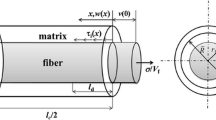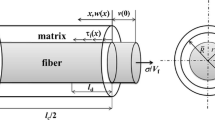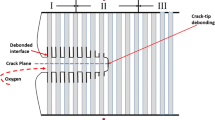Abstract
An analytical method has been developed to investigate the effect of oxidation on the tensile strength of carbon fiber − reinforced ceramic − matrix composites (CMCs). The Budiansky − Hutchinson − Evans shear − lag model was used to describe the micro stress field of the damaged composite considering fibers failure. The statistical matrix multicracking model and fracture mechanics interface debonding criterion were used to determine the matrix crack spacing and interface debonded length. The fiber strength degradation model and oxidation region propagation model have been adopted to analyze the oxidation effect on tensile strength of the composite, which is controlled by diffusion of oxygen gas through matrix cracks. Under tensile loading, the fibers failure probabilities were determined by combining oxidation model and fiber statistical failure model based on the assumption that fiber strength is subjected to two-parameter Weibull distribution and the loads carried by broken and intact fibers statisfy the global load sharing criterion. The composite can no longer support the applied load when the total loads supported by broken and intact fibers approach its maximum value. The conditions of a single matrix crack and matrix multicrackings for tensile strength considering oxidation time and temperature have been analyzed.












Similar content being viewed by others
References
Naslain, R.: Design, preparation and properties of non-oxide CMCs for application in engines and nuclear reactors: an overview. Compos. Sci. Technol. 64, 155–170 (2004). doi:10.1016/S0266-3538(03)00230-6
Naslain, R., Guette, A., Rebillat, F., Gallet, S.L., Lamouroux, F., Filipuzzi, L., Louchet, C.: Oxidation mechanisms and kinetics of SiC-matrix composites and their constituents. J. Mater. Sci. 39, 7303–7316 (2004). doi:10.1023/B:JMSC.0000048745.18938.d5
Lamouroux, F., Camus, G., Thebault, J.: Kinetics and mechanisms of oxidation of 2D woven C/SiC composites: I, experimental approach. J. Am. Ceram. Soc. 77, 2049–2057 (1994). doi:10.1111/j.1151-2916.1994.tb07096.x
Lamouroux, F., Naslain, R., Jouin, J.-M.: Kinetics and mechanisms of oxidation of 2D woven C/SiC composites: II, theoretical approach. J. Am. Ceram. Soc. 77, 2058–2068 (1994). doi:10.1111/j.1151-2916.1994.tb07097.x
Halbig, M.C., McGuffin-Cawley, J.D., Eckel, A.J., Brewer, D.N.: Oxidation kinetics and stress effects for the oxidation of continuous carbon fibers within a microcracked C/SiC ceramic matrix composite. J. Am. Ceram. Soc. 91, 519–526 (2008). doi:10.1111/j.1551-2916.2007.02170.x
Halbig, M.C., Brewer, D.N., Eckel, A.J.: Degradation of continuous fiber ceramic matrix composites under constant-load conditions. NASA/TM − 2000 − 209681 (2000).
Halbig, M.C., Cawley, J.D.: Modeling the environmental effects on carbon fibers in a ceramic matrix at oxidizing conditions. NASA/TM − 2000 − 210223 (2000).
Halbig, M.C.: The oxidation kinetics of continuous carbon fibers in a cracked ceramic matrix composite. NASA/TM − 2001 − 210520 (2001).
Mei, H., Cheng, L.F., Zhang, L.T., Xu, Y.D.: Modeling the effects of thermal and mechanical load cycling on a C/SiC composite in oxygen/argon mixtures. Carbon 45, 2195–2204 (2007). doi:10.1016/j.carbon.2007.06.051
Lara-Curzio, E.: Analysis of oxidation-assisted stress-rupture of continuous fiber-reinforced ceramic matrix composites at intermediate temperatures. Compos. Part A 30, 549–554 (1999). doi:10.1016/S1359-835X(98)00148-1
Casas, L., Martinez-Esnaola, J.M.: Modelling the effect of oxidation on the creep behavior of fiber-reinforced ceramic matrix composites. Acta Mater. 51, 3745–3757 (2003). doi:10.1016/S1359-6454(03)00189-7
Budiansky, B., Hutchinson, J.W., Evans, A.G.: Matrix fracture in fiber-reinforced ceramics. J. Mech. Phys. Solids. 34, 167–189 (1986)
Daniel, I.M., Lee, J.W.: The behavior of ceramic matrix fiber composites under longitudinal loading. Compos. Sci. Technol. 46, 105–113 (1993). doi:10.1016/0266-3538(93)90166-E
Aveston, J., Cooper, G.A., Kelly, A.: Single and multiple fracture. Properties of fiber composites: conference on proceedings. England: National Physical Laboratory, IPC. 15–26 (1971).
Zok, F.W., Spearing, S.M.: Matrix crack spacing in brittle matrix composites. Acta Metall. Mater. 40, 2033–2043 (1992). doi:10.1016/0956-7151(92)90189-L
Zhu, H., Weitsman, Y.: The progression of failure mechanisms in unidirectional reinforced ceramic composites. J. Mech. Phys. Solids. 42, 1601–1632 (1994). doi:10.1016/0022-5096(94)90089-2
Solti, J.P., Mall, S., Robertson, D.D.: Modeling damage in unidirectional ceramic-matrix composites. Compos. Sci. Technol. 54, 55–66 (1995). doi:10.1016/0266-3538(95)00041-0
Curtin, W.A.: Multiple matrix cracking in brittle matrix composites. Acta Metall. Mater. 41, 1369–1377 (1993). doi:10.1016/0956-7151(93)90246-O
Hsueh, C.H.: Crack-wake interface debonding criterion for fiber-reinforced ceramic composites. Acta Mater. 44, 2211–2216 (1996). doi:10.1016/1359-6454(95)00369-X
Gao, Y., Mai, Y., Cotterell, B.: Fracture of fiber-reinforced materials. J. Appl. Math. Phys. 39, 550–572 (1988). doi:10.1007/BF00948962
Sun, Y.J., Singh, R.N.: The generation of multiple matrix cracking and fiber-matrix interfacial debonding in a glass composite. Acta Mater. 46, 1657–1667 (1998). doi:10.1016/S1359-6454(97)00347-9
Filipuzzi, L., Naslain, R.: Oxidation mechanisms and kinetics of 1D-SiC/C/SiC composite materials: II. Modelling. J. Am. Ceram. Soc. 77, 467–480 (1994). doi:10.1111/j.1151-2916.1994.tb07016.x
Casas, L., Martinez-Esnaola, J.M.: Modelling the effect of oxidation on the creep behaviour of fiber-reinforced ceramic matrix composites. Acta Mater. 51, 3745–3757 (2003). doi:10.1016/S1359-6454(03)00189-7
Thouless, M.D., Evans, A.G.: Effects of pull-out on the mechanical properties of ceramic matrix composites. Acta Metall. Mater. 36, 517–522 (1988). doi:10.1016/0001-6160(88)90083-1
Cao, H.C., Thouless, M.D.: Tensile tests of ceramic-matrix composites: theory and experiment. J. Am. Ceram. Soc. 73, 2091–2094 (1990). doi:10.1111/j.1151-2916.1990.tb05273.x
Sutcu, M.: Weibull statistics applied to fiber failure in ceramic composites and work of fracture. Acta Metall. Mater. 37, 651–661 (1989). doi:10.1016/0001-6160(89)90249-6
Schwietert, H.R., Steif, P.S.: A theory for the ultimate strength of a brittle-matrix composite. J. Mech. Phys. Solids. 38, 325–343 (1990). doi:10.1016/0022-5096(90)90002-L
Curtin, W.A.: Theory of mechanical properties of ceramic-matrix composites. J. Am. Ceram. Soc. 74, 2837–2845 (1991). doi:10.1111/j.1151-2916.1991.tb06852.x
Weitsman, Y., Zhu, H.: Multiple-fracture of ceramic composites. J. Mech. Phys. Solids. 41, 351–388 (1993). doi:10.1016/0022-5096(93)90012-5
Hild, F., Domergue, J.M., Leckie, F.A., Evans, A.G.: Tensile and flexural ultimate strength of fiber-reinforced ceramic-matrix composites. Int. J. Solids. Strut. 31, 1035–1045 (1994). doi:10.1016/0020-7683(94)90010-8
Zhu, H., Weitsman, Y.: The progression of failure mechanisms in unidirectional reinforced ceramic composites. J. Mech. Phys. Solids. 42, 1601–1632 (1994). doi:10.1016/0022-5096(94)90089-2
Curtin, W.A., Ahn, B.K., Takeda, N.: Modeling brittle and tough stress–strain behavior in unidirectional ceramic matrix composites. Acta Mater. 46, 3409–3420 (1998). doi:10.1016/S1359-6454(98)00041-X
Paar, R., Valles, J.-L., Danzer, R.: Influence of fiber properties on the mechanical behavior of unidirectionally-reinforced ceramic matrix composites. Mat. Sci. Eng. A 250, 209–216 (1998). doi:10.1016/S0921-5093(98)00593-0
Liao, K., Reifsnider, K.L.: A tensile strength model for unidirectional fiber-reinforced brittle matrix composite. Int. J. Fracture 106, 95–115 (2000). doi:10.1023/A:1007645817753
Zhou, S.J., Curtin, W.A.: Failure of fiber composites: a lattice green function model. Acta Metall. Mater. 43, 3093–3104 (1995). doi:10.1016/0956-7151(95)00003-E
Dutton, R.E., Pagano, N.J., Kim, R.Y.: Modeling the ultimate tensile strength of unidirectional glass-matrix composites. J. Am. Ceram. Soc. 83, 166–174 (2000). doi:10.1111/j.1151-2916.2000.tb01166.x
Xia, Z., Curtin, W.A.: Toughness-to-brittle transitions in ceramic-matrix composites with increasing interfacial shear stress. Acta Mater. 48, 4879–4892 (2000). doi:10.1016/S1359-6454(00)00291-3
Phoenix, S.L., Raj, R.: Scalings in fracture probabilities for a brittle matrix fiber composite. Acta Metall. Mater. 40, 2813–2828 (1992). doi:10.1016/0956-7151(92)90447-M
Wang, Z.J.: Research on mechanical properties of ceramic matrix composites in oxidation environment. Master thesis of Nanjing University of Aeronautics and Astronautics, 2010. (in Chinese)
Li, L.B., Song, Y.D., Sun, Y.C.: Modeling the tensile behvior of unidirectional C/SiC ceramic-matrix composites. Mech. Compos. Mater. 49, 659–672 (2014). doi:10.1007/s11029-013-9382-y
Acknowledgments
The author thanks the Science and Technology Department of Jiangsu Province for the funding that made this research study possible
Compliance with Ethical Standards
ᅟ
Funding
This study has received the support from the Science and Technology Department of Jiangsu Province through the Natural Science Foundation of Jiangsu Province (Grant No. BK20140813).
Conflict of Interest
The author declares that he has no conflict of interest.
Author information
Authors and Affiliations
Corresponding author
Rights and permissions
About this article
Cite this article
Longbiao, L. Modeling the Effect of Oxidation on Tensile Strength of Carbon Fiber−Reinforced Ceramic−Matrix Composites. Appl Compos Mater 22, 921–943 (2015). https://doi.org/10.1007/s10443-015-9443-6
Received:
Accepted:
Published:
Issue Date:
DOI: https://doi.org/10.1007/s10443-015-9443-6




